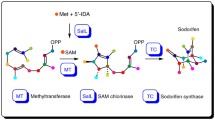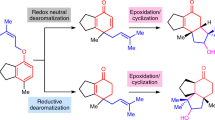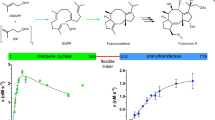Abstract
Terpenes comprise a class of natural products that includes molecules with thousands of distinct structurally and stereochemically complex molecular architectures. The core hydrocarbon frameworks of these molecules are constructed via carbocation rearrangements promoted by terpene synthase (cyclase) enzymes. Although many mechanistic details for such reactions have been uncovered, the factors that control which carbocation intermediates and transition-state structures form are not well understood. Here we show that rearrangement pathways that pass through particular transition-state structures can bifurcate after the transition state. The resulting pathways lead to terpenes with distinctly different skeletons from each other. Although these types of bifurcating pathways have been described previously for some small molecules, the possibility that they may have an important role in the production of complex molecules in nature has, to our knowledge, not previously been considered.
This is a preview of subscription content, access via your institution
Access options
Subscribe to this journal
Receive 12 print issues and online access
$259.00 per year
only $21.58 per issue
Buy this article
- Purchase on Springer Link
- Instant access to full article PDF
Prices may be subject to local taxes which are calculated during checkout




Similar content being viewed by others
References
Christianson, D. W. Structural biology and chemistry of terpenoid cyclases. Chem. Rev. 106, 3412–3442 (2006).
Davis, E. M. & Croteau, R. Cyclization enzymes in the biosynthesis of monoterpenes, sesquiterpenes, and diterpenes. Top. Curr. Chem. 209, 53–95 (2000).
Cane, D. E. Enzymatic formation of sesquiterpenes. Chem. Rev. 90, 1089–1103 (1990).
Christianson, D. W. Unearthing the roots of the terpenome. Curr. Opin. Chem. Biol. 12, 141–150 (2008).
Hong, Y. J. & Tantillo, D. J. Consequences of conformational preorganization in sesquiterpene biosynthesis: theoretical studies on the formation of the bisabolene, curcumene, acoradiene, zizaene, cedrene, duprezianene, and sesquithuriferol sesquiterpenes. J. Am. Chem. Soc. 131, 7999–8015 (2009).
Wang, S. C. & Tantillo, D. J. Prediction of a new pathway to presilphiperfolanol. Org. Lett. 10, 4827–4830 (2008).
Lodewyk, M. W., Gutta, P. & Tantillo, D. J. Computational studies on biosynthetic carbocation rearrangements leading to sativene, cyclosativene, α-ylangene, and β-ylangene. J. Org. Chem. 73, 6570–6579 (2008).
Tantillo, D. J. Recent excursions to the lands between concerted and stepwise: from natural products biosynthesis to reaction design. J. Phys. Org. Chem. 21, 561–570 (2008).
Gutta, P. & Tantillo, D. J. A promiscuous proton in taxadiene biosynthesis? Org. Lett. 9, 1069–1071 (2007).
Hong, Y. J. & Tantillo, D. J. Which is more likely in trichodiene biosynthesis: hydride or proton transfer? Org. Lett. 8, 4601–4604 (2006).
Gutta, P. & Tantillo, D. J. Theoretical studies of farnesyl cation cyclization: pathways to pentalenene. J. Am. Chem. Soc. 128, 6172–6179 (2006).
Bojin, M. D. & Tantillo, D. J. Nonclassical carbocations as C–H hydrogen bond donors. J. Phys. Chem. A 110, 4810–4816 (2006).
Thomas, J. B., Waas, J. R., Harmata, M. & Singleton, D. A. Control elements in dynamically determined selectivity on a bifurcating surface. J. Am. Chem. Soc. 130, 14544–14555 (2008).
Ess, D. H. et al. Bifurcations on potential energy surfaces of organic reactions. Angew. Chem. Int. Ed. 47, 7592–7601 (2008).
Ravn, M. M., Peters, R. J., Coates, R. M. & Croteau, R. Mechanism of abietadiene synthase catalysis: stereochemistry and stabilization of the cryptic pimarenyl carbocation intermediates. J. Am. Chem. Soc. 124, 6998–7006 (2002).
Ravn, M. M., Coates, R. M., Jetter, R. & Croteau, R. B. Stereospecific intramolecular proton transfer in the cyclization of geranylgeranyl diphosphate to (–)-abietadiene catalyzed by recombinant cyclase from grand fir (Abies grandis). Chem. Commun. 21–22 (1998).
Ravn, M. M., Coates, R. M., Flory, J. E., Peters, R. J. & Croteau, R. Stereochemistry of the cyclization rearrangement of (+)-copalyl diphosphate to (–)-abietadiene catalyzed by recombinant abietadiene synthase from Abies grandis. Org. Lett. 2, 573–576 (2000).
Wilderman, P. R. & Peters, R. J. A single residue switch converts abietadiene synthase into a pimaradiene specific cyclase. J. Am. Chem. Soc. 129, 15736–15737 (2007).
Fukui, K. The path of chemical reactions – the IRC approach. Acc. Chem. Res. 14, 363–368 (1981).
Gonzalez, C. & Schlegel, H. B. Reaction path following in mass-weighted internal coordinates. J. Phys. Chem. 94, 5523–5527 (1990).
Nouri, D. H. & Tantillo, D. J. Hiscotropic rearrangements: hybrids of electrocyclic and sigmatropic reactions. J. Org. Chem. 71, 3686–3695 (2006).
Williams, C. D. et al. Intramolecular proton transfer in the cyclization of geranylgeranyl diphosphate to the taxadiene precursor of taxol catalyzed by recombinant taxadiene synthase. Chem. Biol. 7, 969–977 (2000).
Chow, S. Y., Williams, H. J., Huang, Q., Nanda, S. & Scott, A. I. Studies on taxadiene synthase: interception of the cyclization cascade at the isocembrene stage with GGPP analogs. J. Org. Chem. 70, 9997–10003 (2005).
Allemann, R. K., Young, N. J., Ma, S., Truhlar, D. G. & Gao, J. Synthetic efficiency in enzyme mechanisms involving carbocations: aristolochene synthase. J. Am. Chem. Soc. 129, 13008–13013 (2007).
Miller, D. J. et al. Stereochemistry of eudesmane cation formation during catalysis by aristolochene synthase from Penicillium roqueforti. Org. Biomol. Chem. 6, 2346–2354 (2008).
Cane, D. E., Prabhakaran, P. C., Oliver, J. S. & McIlwaine, D. B. Aristolochene biosynthesis. Stereochemistry of the deprotonation steps in the enzymatic cyclization of farnesyl pyrophosphate. J. Am. Chem. Soc. 112, 3209–3210 (1990).
Surendra, K. & Corey, E. J. Rapid and enantioselective synthetic approaches to germanicol and other pentacyclic triterpenes. J. Am. Chem. Soc. 130, 8865–8869 (2008).
Reetz, M. T. Dyotropic rearrangements, a new class of orbital-symmetry controlled reactions. Type I. Angew. Chem. Int. Ed. Engl. 11, 129–130 (1972).
Reetz, M. T. Dyotropic rearrangements, a new class of orbital-symmetry controlled reactions. Type II. Angew. Chem. Int. Ed. Engl. 11, 130–131 (1972).
Reetz, M. T. Primary and secondary orbital effects in dyotropic rearrangements. Tetrahedron 29, 2189–2194 (1973).
Reetz, M. T. Dyotropic rearrangements and related σ–σ exchange processes. Adv. Organomet. Chem. 16, 33–65 (1977).
Hoffmann, R. & Williams, J. E. Jr The stabilization of bridged structures of ethanes. Helv. Chim. Acta 55, 67–75 (1972).
Streitwieser, A., Jayasree, E. G., Hasanayn, F. & Leung, S.-H. A theoretical study of SN2′ reactions of allylic halides: role of ion pairs. J. Org. Chem. 73, 9426–9434 (2008).
Carpenter, B. K. Intramolecular dynamics for the organic chemist. Acc. Chem. Res. 25, 520–528 (1992).
Carpenter, B. K. Nonexponential decay of reactive intermediates: new challenges for spectroscopic observation, kinetic modeling and mechanistic interpretation. J. Phys. Org. Chem. 16, 858–868 (2003).
Frisch, M. J. et al. Gaussian03, revision D.01 (Gaussian, Pittsburgh, Pennsylvania, 2003).
Becke, A. D. Density-functional thermochemistry. 3. The role of exact exchange. J. Chem. Phys. 98, 5648–5652 (1993).
Becke, A. D. A new mixing of Hartree–Fock and local density–function theories. J. Chem. Phys. 98, 1372–1377 (1993).
Lee, C., Yang, W. & Parr, R. G. Development of the Colle–Salvetti correlation–energy formula into a functional of the electron density. Phys. Rev. B 37, 785–789 (1988).
Stephens, P. J., Devlin, F. J., Chabalowski, C. F. & Frisch, M. J. Ab initio calculation of vibrational absorption and circular-dichroism spectra using density-functional force-fields. J. Phys. Chem. 98, 11623–11627 (1994).
Matsuda, S. P. T., Wilson, W. K. & Xiong, Q. Mechanistic insights into triterpene synthesis from quantum mechanical calculations. Detection of systematic errors in B3LYP cyclization energies. Org. Biomol. Chem. 4, 530–543 (2006).
Zhao, Y. & Truhlar, D. G. Hybrid meta density functional theory methods for thermochemistry, thermochemical kinetics, and noncovalent interactions: the MPW1B95 and MPWB1K models and comparative assessments for hydrogen bonding and van der Waals interactions. J. Phys. Chem. A 108, 6908–6918 (2004).
Zheng, J., Zhao, Y. & Truhlar, D. G. Representative benchmark suites for barrier heights of diverse reaction types and assessment of electronic structure methods for thermochemical kinetics. J. Chem. Theory Comput. 3, 569–582 (2007).
Müller, N., Falk, A. & Gsaller, G. Ball & Stick V.4.0a12, Molecular Graphics Application for MacOS Computers (Johannes Kepler University, Linz, 2004).
Acknowledgements
We gratefully acknowledge the University of California, Davis, and the National Science Foundation's CAREER and Partnership for Advanced Computational Infrastructure programmes for their support. We are also grateful to M. W. Lodewyk, M. R. Siebert and S. C. Wang (University of California, Davis) for helpful comments.
Author information
Authors and Affiliations
Contributions
D.J.T. and Y.J.H. conceived and designed the experiments, analysed the data and co-wrote the paper. Y.J.H. performed the experiments.
Corresponding author
Supplementary information
Supplementary information
Supplementary information (PDF 2549 kb)
Rights and permissions
About this article
Cite this article
Hong, Y., Tantillo, D. A potential energy surface bifurcation in terpene biosynthesis. Nature Chem 1, 384–389 (2009). https://doi.org/10.1038/nchem.287
Received:
Accepted:
Published:
Issue Date:
DOI: https://doi.org/10.1038/nchem.287
This article is cited by
-
An enantioselective ambimodal cross-Diels–Alder reaction and applications in synthesis
Nature Catalysis (2021)
-
“Cation-Stitching Cascade”: exquisite control of terpene cyclization in cyclooctatin biosynthesis
Scientific Reports (2015)
-
Biosynthetic consequences of multiple sequential post-transition-state bifurcations
Nature Chemistry (2014)
-
It's all downhill from here
Nature Chemistry (2014)
-
Effect of a chiral electrostatic cavity on product selection in a reaction with a bifurcating reaction path
Theoretical Chemistry Accounts (2014)



